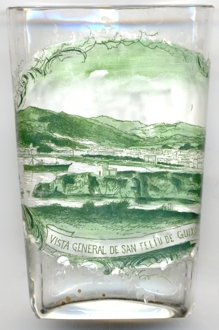

|
| ESPAÑA | Spain |
| Catalunya / Cataluña | Catalonia |
| Provincia: Girona / Gerona | Girona |
 Sant Feliu de Guíxols is situated on the Costa Brava, about 85 km northeast of Barcelona and about
28 km southeast of the
provincial capital, Girona. The municipality has a population of about 21,900 (2019). The name Sant Feliu goes back to Saint Felix of Africa, a Roman
legionnaire, who, according to legend, was martyred in 304. The addition de Guíxols comes from the hills on which the ancient precursor settlement
was located; the etymology of this designation has not been firmly established; one explanation that has been suggested is that it is derived from
the word iecsalis from a 10th-century document presumably meaning 'rope-maker'.
Sant Feliu de Guíxols is situated on the Costa Brava, about 85 km northeast of Barcelona and about
28 km southeast of the
provincial capital, Girona. The municipality has a population of about 21,900 (2019). The name Sant Feliu goes back to Saint Felix of Africa, a Roman
legionnaire, who, according to legend, was martyred in 304. The addition de Guíxols comes from the hills on which the ancient precursor settlement
was located; the etymology of this designation has not been firmly established; one explanation that has been suggested is that it is derived from
the word iecsalis from a 10th-century document presumably meaning 'rope-maker'.
Archaeological excavations have unearthed traces of a first settlement of Iberians, dating from around 400 BC. The population was Romanized
and Christianized in late antiquity. A continuity of this settlement is not proven. The founding of the Benedictine monastery of Sant Feliu in the
10th century, which successively attracted settlers, is therefore presumably independent of the ancient founding. The monastery exercised feudal
rule in the region, which it formally held until 1835 when all Benedictine monasteries in Spain were abolished. In the course of the Middle Ages, the
city, which grew around the monastery, developed increasing independence from feudal rule due to its economic importance. The harbor with the shipyards
was already built in the 12th century. Sant Feliu became prosperous in the 14th century, when the town received the privileges of a city.
In the second half of the 18th and 19th centuries, the cork industry surpassed fishing as the main source of income and Sant Feliu became the main
international export port for the raw material extracted from the nearby cork oak forests. Towards the end of the 19th century the city expanded
considerably. The construction of a narrow-gauge railway between 1889 and 1892 increased the importance of Sant Feliu as a trading port, since goods
could now also be transported from inland via Girona for loading. The rise of Sant Feliu as a tourist center began in the second half of the
20th century. In contrast to other tourist centres on the Costa Brava, which during the the construction boom of the 1960s and 1970s opened up for
package tourism, Sant Feliu remained geared towards moderate numbers of visitors when it came to expanding its accommodation and gastronomic facilities.
[https://de.wikipedia.org/wiki/Sant_Feliu_de_Gu%C3%ADxols, https://en.wikipedia.org/wiki/Sant_Feliu_de_Gu%C3%ADxols]
![[scale]](lineal.jpg)